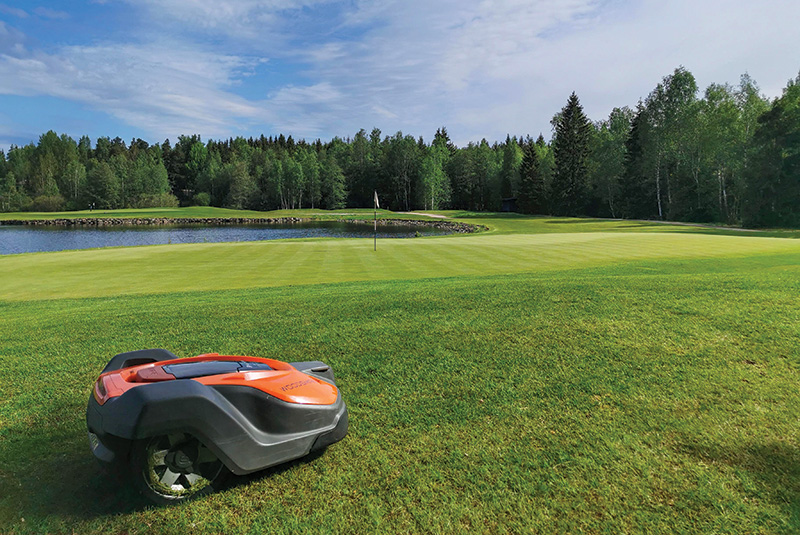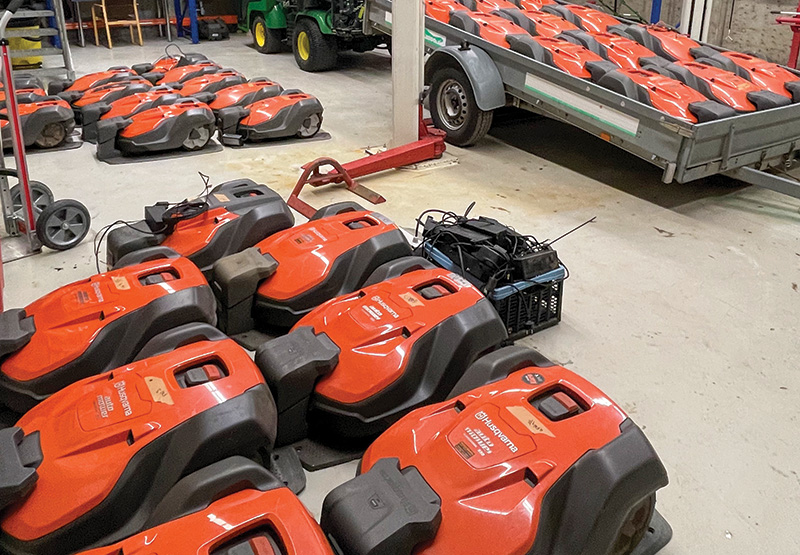
Since starting its journey with robotic “automowers” in 2019, Hirsala Golf has progressed to the point it has 36 units now, which handle the mowing for all of the course’s fairways and 75% of the rough and semirough areas. Photo courtesy of Hirsala Golf
Golf course management is experiencing a transformative era, and Hirsala Golf in Finland is leading the way. The integration of robotic mowers into its daily operations not only exemplifies sustainability but also redefines the golfing experience. This review takes a look at the innovative sustainable practices implemented by Hirsala Golf, offering valuable insights for the members of GCSAA aiming to explore new standards of environmental conscientiousness.
Nordic countries, known for their commitment to environmental stewardship, have consistently led the way in adopting sustainable practices across various industries. In golf course management, the emphasis on environmental sustainability is a hallmark of Nordic courses. Hirsala Golf, situated in the picturesque Finnish landscape, epitomizes this commitment by deploying cutting-edge solutions to minimize its ecological footprint while maximizing efficiency.
Here are a few key elements of the environmental stewardship practices at Hirsala Golf.
Robotic mowers: The future of turf management
Hirsala Golf’s adoption of robotic mowers represents a significant leap toward sustainable turf management. These autonomous machines have been deployed to maintain the golf course with precision, effectively reducing reliance on traditional, fuel-dependent mowers. The robotic mowers at Hirsala Golf are not only environmentally friendly but also economically viable, contributing to substantial long-term cost savings.
Hirsala Golf started its journey with robotics together with Husqvarna, a company based in Sweden, in 2019 by organizing an on-course demonstration utilizing mowing units previously suited mainly to home lawns. Quickly the club learned that the mowing quality, reception by players and staff and environmental impact all were improved. Also reviewed was the impact on compaction, disease and weed pressure and plant health. The condensed mowing frequency and quiet, pollution-free operation of these machines was impressive enough for the club to start investing in a full fleet of “automowers.”
So far, the club has invested in 36 robotic units that cover 100% of the fairways and about 75% of the mowed rough and semi-rough on the course. Transformation of the traditional golf course management fleet into the fleet from the future has been done over time, phase by phase. There is still need for traditional machinery as backups, but the fleet is very different than you would normally see at an 18-hole facility.
The precision of these robotic mowers is noteworthy. Following pre-programmed routes, they ensure a consistent and even turf height throughout the course. The height of cut on the fairways and roughs is the same every day, due to frequent mowing. This precision elevates the aesthetic appeal of the golf course and contributes to improved playing conditions, a factor highly valued by the members and visitors of the club.

Janne Lehto, MG, is the GCSAA Class A superintendent of Hirsala Golf, Finland, and president of the Finnish Greenkeepers Association. He is an eight-year member of GCSAA. Photo courtesy of Janne Lehto
Reducing emissions and noise pollution
Traditional gas-powered mowers have long been associated with contributing to air and noise pollution, elements that detract from the serene ambiance that golf courses aspire to provide. Hirsala Golf’s strategic shift to robotic mowers directly addresses these concerns. Operating on electric power and characterized by silent operation, these automowers allow golfers to enjoy the round of golf in the natural beauty of the course without the typical disturbances associated with maintenance activities.
This reduction in emissions not only aligns with the club’s environmental goals but also makes a positive impact on the overall health of the golf course and its surroundings. The silent operations contribute to a more peaceful atmosphere, enhancing the overall golfing experience, and has been noticed also by the neighbors living next to the golf course.
Enhancing biodiversity and habitat preservation
Hirsala Golf’s commitment to sustainability extends beyond turf management. The reduced use of traditional mowers also positively influences biodiversity on the course. The club has been able to change its mowing regime from early mornings to 24/7 operation without noise. This helps the wild animals on-site stay undisturbed. The golf course becomes not merely a playing ground but a habitat supporting diverse ecosystems, fostering a harmonious balance between nature and recreation.
Also, introduction of more native plants on the site has been possible and is planned further as there is no need for thought of certain mower dimensions to fit in. The automowers are agile and will allow more nature to be incorporated in the future golf course designs, which has been taken into consideration at Hirsala when creating the master plan together with Christian Lundin of Re/Golf Design.
Adapting to Nordic climate challenges
Nordic countries face unique climate challenges, with cold winters and short growing seasons, where the bloom and growth of plants is extremely vigorous during the few summer months. Hirsala Golf’s embrace of robotic mowers is a testament to adaptability in such conditions. These machines can operate effectively in various weather conditions, ensuring the grass is mowed even right after heavy precipitation when heavier units are still waiting to get out. This allows them to always stay on top of the growth and create great course conditions.
With the ability to operate in varying weather conditions, Hirsala Golf ensures that the golf course remains accessible and well maintained, offering golfers an extended season and maintaining revenue streams for the course.

Hirsala Golf’s fleet of robotic mowers. Photos courtesy of Hirsala Golf
Cost reductions through robotic mowers
While the environmental benefits of robotic mowers are evident, the financial advantages are equally compelling. Hirsala Golf has experienced significant cost reductions since the adoption of these machines. The investment cost into the fleet has been reasonable, and traditional mowers come with high fuel costs, maintenance expenses and labor requirements. The transition to robotic mowers has substantially cut down on these expenditures. Fuel usage on fairways and rough areas has reduced from 4,000 liters of fuel per year to only 400 liters of fuel per year since 2019.
Robotic mowers operate on electricity, a more cost-effective energy source compared to traditional fuel. The electricity at Hirsala is produced mainly by solar power, with two solar plants installed on the clubhouse and maintenance building roofs.
Automowers require minimal maintenance, reducing the need for frequent and costly repairs associated with traditional machinery. Additionally, the autonomous nature of these robots eliminates the need for a dedicated human operator for every mower, allowing the professional greens staff to work on more demanding tasks that further raise the quality of the golf course. For Hirsala, it was one of the keys that none of the staff will be reduced due to changing to automatic mowers. Instead, the change has created need for new knowhow and expertise — namely, the club has a new role of golf course automation specialist in its course management team. Similar to an irrigation technician taking care of the irrigation system, the automation specialist takes care of ‘’the mowing system’’ consisting of robotic mowers.
Hirsala Golf’s financial success with robotic mowers is a testament to the long-term economic viability of such sustainable practices.
The initial investment in robotic technology pays off over time through reduced operational costs, positioning the golf course for financial sustainability while simultaneously contributing to environmental conservation.

Hirsala Golf in Finland. Photo courtesy of Hirsala Golf
Future opportunities with robotics and sensor technology
The future is exciting with robotics and automation. There are plenty of different benefits associated with modern technology that will likely aid in decision making, efficiency and even customer experience.
The adoption of robotic mowers at Hirsala Golf not only addresses current sustainability and cost concerns but also opens exciting future opportunities in golf course management. As technology continues to advance, the integration of robotics and sensor technology presents new avenues for enhancing golf courses.
Precision agronomy in turf management. Robotic mowers equipped with advanced sensors will be able to gather detailed data on plant health, soil conditions, moisture levels and nutrient content. This information allows superintendents to implement precision agronomic decision making and techniques, optimizing the use of water and fertilizers. By tailoring inputs to the specific needs of each area of the course, superintendents can further reduce environmental impact and enhance resource efficiency.
Smart irrigation and weather sensing. Sensors integrated into the mowers could provide real-time data on soil moisture, weather conditions and evapotranspiration rates. This information could be utilized to implement smart irrigation systems that automatically adjust watering schedules based on actual needs. Such systems not only conserve water but also contribute to healthier turf and reduced energy consumption.
Autonomous equipment for other maintenance tasks. Beyond mowing, robotics can be extended to other maintenance tasks on the golf course. Autonomous equipment could be developed for tasks like aeration, topdressing and pest control. This expansion of robotic capabilities can streamline operations, reduce labor costs and minimize the environmental impact associated with traditional maintenance practices.
Enhanced golfer experience through technology. Integrating technology doesn’t only benefit course management but can enhance the overall golfer experience. Sensor technology can be used to develop interactive apps that provide golfers with real-time information about course conditions, personalized tips and even suggestions for optimal playing strategies based on current turf health and weather conditions.
As golf courses worldwide seek ways to minimize their environmental impact, Hirsala Golf of Finland stands as an example of positive change. The integration of robotic electric mowers is not merely a modernization of maintenance practices; it’s a commitment to a greener, more sustainable future for the sport.
By drawing lessons from the Nordic approach, golf courses globally can embrace these transformative technologies, contributing to a harmonious coexistence of the sport and the environment. The financial benefits realized by Hirsala Golf underscore the practicality and wisdom of adopting sustainable practices, providing a compelling case for the golf industry to follow suit.
Janne Lehto, MG, is the GCSAA Class A superintendent of Hirsala Golf, Finland, and president of the Finnish Greenkeepers Association. He is an eight-year member of GCSAA.